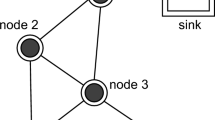Abstract
In wireless sensor networks, when a sensor node detects events in the surrounding environment, the sensing period for learning detailed information is likely to be short. However, the short sensing cycle increases the data traffic of the sensor nodes in a routing path. Since the high traffic load causes a data queue overflow in the sensor nodes, important information about urgent events could be lost. In addition, since the battery energy of the sensor nodes is quickly exhausted, the entire lifetime of wireless sensor networks would be shortened. In this paper, to address these problem issues, a new routing protocol is proposed based on a lightweight genetic algorithm. In the proposed method, the sensor nodes are aware of the data traffic rate to monitor the network congestion. In addition, the fitness function is designed from both the average and the standard deviation of the traffic rates of sensor nodes. Based on dominant gene sets in a genetic algorithm, the proposed method selects suitable data forwarding sensor nodes to avoid heavy traffic congestion. In experiments, the proposed method demonstrates efficient data transmission due to much less queue overflow and supports fair data transmission for all sensor nodes. From the results, it is evident that the proposed method not only enhances the reliability of data transmission but also distributes the energy consumption across wireless sensor networks.
Similar content being viewed by others
References
Akyildiz, I.-F., Su, W., Sankarasubramaniam, Y., Cayirci, E.: Wireless sensor networks: a survey. Comput. Netw. 38, 393–422 (2002)
Polastre, J., Szewczyk, R., Sharp, C., Culler, D.: The mote revolution: low power wireless sensor network devices. In: Proceedings of Hot Chips 16: A Symposium on High Performance Chips, August 2004
Sankarasubramaniam, Y., Akan, O.B., Akyildiz, I.F.: ESRT: event-to-sink reliable transport for wireless sensor networks. In: Proceedings of the 4th ACM International Symposium on Mobile Ad Hoc Networking and Computing, June 2003, pp. 177–188 (2003)
Maimour, M., Pham, C., Amelot, J.: Load repartition for congestion control in multimedia wireless sensor networks with multipath routing. In: Proceedings of the 3rd International Symposium on Wireless Pervasive Computing (ISWPC’08), pp. 11–15 (2008)
Dietrich, I., Dressler, F.: On the lifetime of wireless sensor networks. ACM Trans. Sens. Netw. (TOSN) 5 (2009)
Wan, C., Eisenman, S., Campbell, A.: CODA: congestion detection and avoidance in sensor networks. In: Proceedings of the 1st ACM Conference on Embedded Networked Sensor Systems, November 2003, pp. 266–279 (2003)
Goldberg, D.E.: Genetic Algorithms in Search, Optimization and Machine Learning. Addison–Wesley, Reading (1989)
Author information
Authors and Affiliations
Corresponding author
Additional information
This research was supported by the MKE (The Ministry of Knowledge Economy), Korea, under the “ “Smart IT Lighting Education Center” support program supervised by the NIPA (National IT Industry Promotion Agency)” (NIPA-2010-C6150-1001-0016).
Rights and permissions
About this article
Cite this article
Park, C., Kim, H. & Jung, I. Traffic-aware routing protocol for wireless sensor networks. Cluster Comput 15, 27–36 (2012). https://doi.org/10.1007/s10586-010-0146-3
Received:
Accepted:
Published:
Issue Date:
DOI: https://doi.org/10.1007/s10586-010-0146-3




